
Home About Us Contact Us Subscribe

Home About Us Contact Us Subscribe
|
|
|
|
Exhibition : "Laboratories" at the Canadian Centre for Architecture
Montreal: Six young architectural firms take over CCA galleries to explore the shape of things to come. by ArchNewsNow April 15, 2002 “Architecture
is about imagination. Suddenly we have witnessed the unimaginable, and
imagination has been taken from us. Can we architects ever imagine again?” Peter
Eisenman, September 2001 In the belief that September 11, 2001, poses an urgent demand
to construct a new stage for thought and action — and in the conviction that
architecture generates not only spaces, but also ideas and potentialities — the Canadian Centre for Architecture
has overturned its exhibition schedule and organized “Laboratories”. The
yearlong initiative, comprising a major exhibition and extensive programs of
discussion and debate, will turn the galleries of the CCA into a public square:
a place for reflection, response, and the exchange of ideas. At the core of “Laboratories” is an exhibition, on
view from April 18 to September 15, 2002, which highlights the emergence in
Montreal of a cluster of inventive architectural firms. Six of these innovative
ateliers, all of them in existence for 15 years or less, will create an environment or installation that expresses
their current thinking about the world they might inhabit and the one they
might want to shape. The firms are: Atelier Big City;
Atelier BRAQ; Atelier in situ; Bosses design; BUILD; and
Pierre Thibault (links below). “I believe the CCA is itself one of the cultural
forces that has made this initiative possible,” says Nicholas Olsberg, Director
of the CCA. “Over the last 10 years, I think we have helped widen and deepen
the discourse of architecture, and so have contributed to the explosion in our
city of new approaches to practice. Through “Laboratories”, we now seek to
advance these developments by fostering the ‘intense human interaction’ that
Phyllis Lambert has identified as the critical generative force for new ideas
in architecture today.” The CCA launched “Laboratories” in November 2001 by
issuing a project statement and a call for proposals. The jury (listed below)
met in mid-December to select the architects to participate in the project. The
jury based its decisions on the firms’ demonstrated capacity for thinking
outside usual boundaries, their ability to work in a multidisciplinary team,
and the quality of their work. The CCA then invited two leading architectural thinkers,
Frédéric Migayrou, Director of Architecture at the Centre national d’art et de
culture Georges Pompidou in Paris, and Mark Wigley, Professor of Architecture,
Graduate School of Architecture/Planning and Preservation at Columbia
University, along with a panel of critics and artists to join in discussions
with the architects to help clarify and extend their ideas before they
proceeded with their installations. Three of the firms chosen (Atelier in situ, Atelier
Big City, and Pierre Thibault) have won the prestigious Prix de Rome awarded by
the Canada Council for the Arts. Previous work produced by the six firms ranges
from residential and commercial construction and renovation to exhibition
design. Their various Montreal projects include the Usine Poste (Atelier BRAQ
in collaboration with Carlos Ott); the redesign of the foyer of Marché
Bonsecours (Atelier Big City); the conversion of the Darling Foundry
for the city’s Quartier Éphémère (Atelier in situ); the bistro Le Petit Alep
(Bosses design); a series of houses in Plateau Mont-Royal, including the BOX
house (BUILD); and the Espace chorégraphique Jean-Pierre Perreault (Pierre
Thibault). Frédéric Migayrou states: “The younger generation of
Montréal architects is important as both a critical and a practical resource.
By creating a place where they can propose questions and pursue research, the
CCA makes a vital contribution to their role in the city as well as their
emergence worldwide.” His comments echo Mark Wigley: “In an act of
extraordinary courage and generosity, CCA has turned its galleries over to the
architects themselves, opening a space for reflection and active response.” Once the installations are in place, discussions will
be opened to the public in the galleries themselves and through a series of
lectures, round tables, and symposia, culminating in a forum and public events
the weekend of September 14. A major publication, written and edited by Wigley
and Migayrou, will follow. “For a period of a year, the CCA is becoming a public
laboratory, a site of creation and conversation,” Olsberg concludes. “That
laboratory is now open.” Links: You can follow the progress of the project, step by
step, by visiting “Laboratories”,
the Web site set up especially for the event. It’s also worth a trip to the participants’ own Web
sites (they’re a mix of English/French, French only, and one – we’re not sure): Atelier Big City
(Randy Cohen, Anne Cormier,
Howard Davies) Atelier BRAQ
(Wade Eide, Peter Fianu) Atelier in
situ (Annie Lebel, Geneviève L'Heureux, Stéphane Pratte) Bosses design
(Éric Daoust, Donald Potvin, Jean-François Potvin) BUILD (Michael Carroll, R. Wayne Guy, Danita
Rooyakkers, Attila Tolnai) Pierre
Thibault (Pierre Thibault) Jury: Georges Adamczyk, Director, School of Architecture,
Université de Montréal; Sylvie Gilbert, Director/Curator, Liane and Danny
Taran Gallery of the Saidye Bronfman Centre for the Arts; Caroline Andrieux, Director, Quartier Éphémère; Louise Pelletier, adjunct professor, School of
Architecture, McGill University, teacher, School of Design, Université du
Québec à Montréal; Denis Lemieux, architect. The
CCA wishes to thank Hydro-Québec and Loto-Québec for their generous support of
the exhibition. Also thanks to Lafarge Canada, Bank of Montreal, RBC Financial
Group, Calgah Computer Systems, and Liberty Yogourt for their support of the
exhibition and the public programs. The CCA gratefully acknowledges the
generous support of the Ministère de la Culture et des Communications du
Québec, the Canada Council for the Arts, the Department of Canadian Heritage,
and the Conseil des arts de Montréal. |
(click on pictures to enlarge) 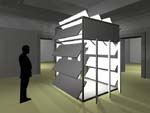 ((c) Atelier in situ) Atelier in situ: Digital image of proposed installation (Michel Boulet (c)Centre Canadien d'Architecture/Canadian Centre for Architecture, Montréal) Atelier in situ: Model of proposed installation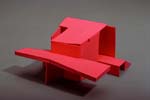 (Michel Boulet (c)Centre Canadien d'Architecture/Canadian Centre for Architecture, Montréal) Atelier Big City: Model of proposed installation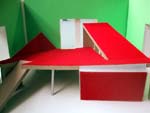 ((c) Atelier Big City) Atelier Big City: Digital image of proposed installation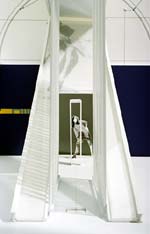 (Michel Boulet (c)Centre Canadien d'Architecture/Canadian Centre for Architecture, Montréal) BUILD: Model of proposed installation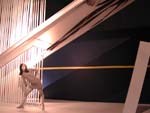 ((c) BUILD) BUILD: Digital image of proposed installation (Michel Boulet (c)Centre Canadien d'Architecture/Canadian Centre for Architecture, Montréal) Atelier BRAQ: Model of proposed installation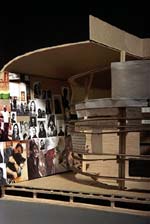 (Michel Boulet (c)Centre Canadien d'Architecture/Canadian Centre for Architecture, Montréal) Pierre Thibault: Model of proposed installation (Michel Boulet (c)Centre Canadien d'Architecture/Canadian Centre for Architecture, Montréal) Pierre Thibault: Model of proposed installation (Michel Boulet (c)Centre Canadien d'Architecture/Canadian Centre for Architecture, Montréal) Bosses design: Model of proposed installation |
© 2002 ArchNewsNow.com